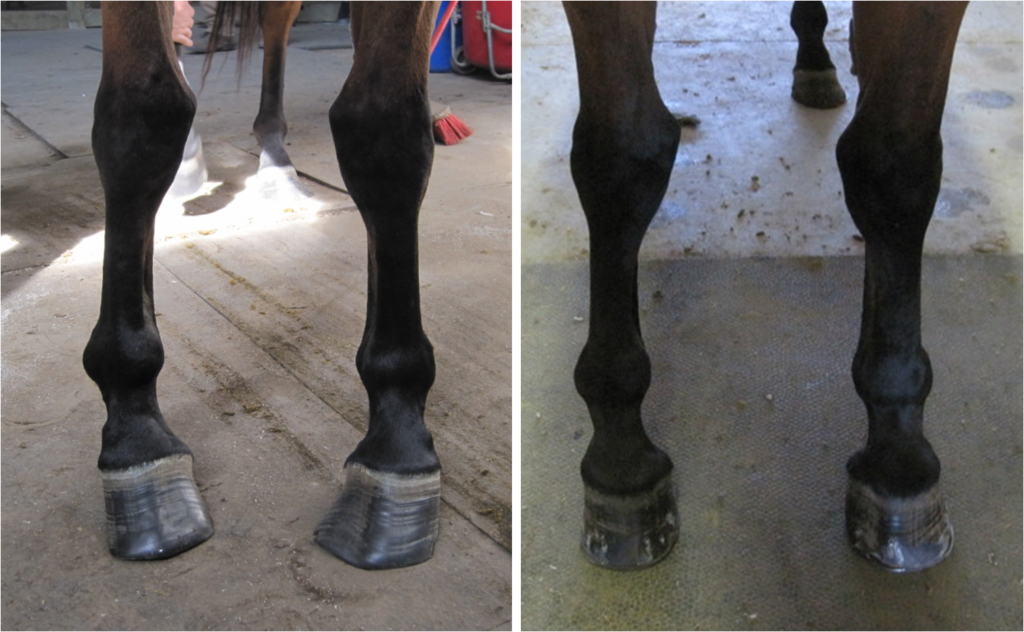Can it be Fixed? – Part 2

This angular deformity causes uneven weight distribution and therefore pain to this horse. Applying lateral extension shoes helps this horse to not be lame as well as makes the conformation look straighter. However, it is not permanently fixed.
Last week (Can it be Fixed?), we talked about crooked-legged horses that are not lame. Non-lame horses do not need to have their conformation cosmetically “fixed”, but rather should be balanced in the way that makes them the most comfortable. But what about crooked-legged horses that do become lame because of their conformation? What should the farrier’s role be then? Farriers should learn all they can about limb and foot conformation and the effect that trimming and/or shoeing will or won’t have on the horse.
It is important to know what caused the legs to become crooked in the first place. Sixty-five percent of crooked limbs are the result of genetics, while the other thirty-five percent can be caused by the horse’s environment before (congenital) or after (developmental) birth. A foal that is born with crooked legs may be helped before epiphyseal growth plates close. If medial or lateral extension shoes are applied at this critical time while the bones are still malleable, the shoe can act as a lever that helps the leg to grow straight. The time to “correct” or straighten crooked legs is most effective before the foal is 9 months old.
Many extremely crooked-legged horses have been “straightened up” to where the initial problem is almost completely unrecognizable. The horse could pass as one with almost ideal conformation. This is good news if the horse developed the crooked condition. However, if the horse contracted the crooked conformation from genetics and the horse is utilized to perpetuate blood lines, the solution will be short-lived. The horse’s offspring will have a high likelihood of a crooked conformation.
Some horses don’t have access to a competent, corrective farrier in their early years. Because no efforts are made to ply the young impressionable bones, the epiphyseal growth plates close in their distorted state. As time goes on, the horse becomes lame (usually in the joints) because of uneven weight distribution. For these horses, excessive hoof growth means more strain on the joints and therefore more pain. A regular trimming interval is crucial to help these horses feel comfortable. A shoe that extends medially or laterally can also take some strain off of joints and distribute weight more evenly. As an added bonus, it usually makes the feet look better too!
A few years ago, a lame, 10-year old mare with an extremely fetlock varus (toed-in) conformation was donated to our school. It was too late to “correct” or straighten the conformation because the growth plates had closed a long time ago. In order to accommodate her specific conformation, we built and applied lateral extension shoes that extended under her center of gravity. She immediately felt the effects of the shoes and exhibited lesser signs of lameness. As time went on, she came to rely on those shoes. One day a few years later, I discovered her lying down in the pasture and not willing to get up. Upon closer inspection, I found that she had thrown one of her shoes! After reapplying the shoe, she happily went back to grazing in the pasture. She seemed to depend on the shoes to get around! It wouldn’t be appropriate to say this horse is fixed because she will always have the problem. But she is certainly able to function better with the regular hoof maintenance and the proper footwear.
Each horse must be assessed individually and a treatment plan should be made and followed for that specific horse. Studying conformation and the effect of trimming and shoeing will help to make a treatment plan. Sometimes all you can do is try different treatment plans and observe how the horse responds. If a treatment plan is not working, you may have to explore other options. The goal should be to “do no harm” and help the horse be as comfortable and functional as it can be.
Related Posts
-
National Day of the Horse is observed every year on December...Dec 13, 2018 / 0 comments
-
No one who achieves success does so without acknowledging th...Feb 13, 2010 / 0 comments
-
Recently I was discussing the state of the farrier business ...Jul 26, 2012 / 0 comments
Blog Categories
- Anatomy
- Best Business Practices
- Conformation
- Current Events
- Customer Service
- Draft Horse Shoeing
- Equine Soundness
- Essential Anatomy Kit
- Farrier Careers
- Farrier training
- Foal soundness
- Horse Care
- Horse Foot Care
- Horse Owner Tips
- Horsemanship
- Horseshoeing
- Horseshoeing History
- Iron and Forge Work
- Student Spotlight
- Uncategorized
- Veterinary Care
Blog Archives
Contact Us
Butler Professional Horseshoeing School
495 Table Road
Crawford, NE 69339
(800) 728-3826
jacob@dougbutler.com
Subscribe to Our Blog
Get Our Free e-Book!
If you think you want to become a farrier (or know someone who does), this book can help you make that decision. Horse owners will learn the importance of choosing a qualified farrier and how to select the “right” one.
[ Get the e-Book Now! ]
- Follow:
